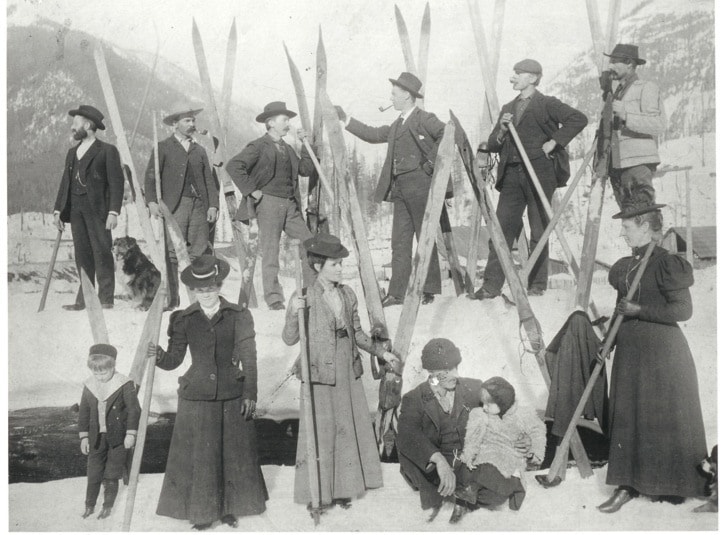This is the first of an eight part series of excerpts from First Tracks: A History of Skiing in Revelstoke, the latest book from the Revelstoke Museum & Archives.
By the Revelstoke Museum & Archives
Most early skiing seems to have been recreational and non-competitive. In the early 1890s, Revelstoke skiers founded a recreational ski club and merchant F.B. Wells imported 10-foot-long skis with intricate scrollwork from Minnesota for his store. The ski club included Wells, another merchant, Guy Barber, and mining entrepreneurs W.B. Pool, J. Maunsel, T. Horn and E.L. Kinman. These men went out regularly to ski down local slopes, an early form of downhill skiing.
In February 1900, an article in the American Munsey’s Magazine featured “ski running” in Revelstoke and described the Revelstoke club as “well-known” and “composed of many of the leading businessmen of the place.” The writer contrasted the ski harnesses that were developed in western Canada with those in Norway and Quebec, suggesting that western Canadians, possibly in Revelstoke, were innovating:
(Skis) made in Norway carry a simple strap for the feet, but the Canadian ski is more elaborately equipped. In the Quebec districts three straps are used and in the West, among the Rockies, local followers of this king of sports have adopted a half shoe arrangement with an extra strap for the heel. The latter, however, is used solely in climbing, the buckle being unfastened before and extended ‘shoot’ (downhill run) is taken.
The article described the single pole that skiers used which was:
…a requisite to safe running. This is a long, stout stick, usually of hickory. It has a knob at the lower end, and a few inches higher up a strong leather washer. The pole is to the ski runner what the rudder is to a ship. Both the knob and the washer are held in the snow, the former when the speed is light, and the other in case a strong, quick effort, such as the sudden turning of an obstacle, is desired.
This article and other item in the Kootenay Mail indicate that the Revelstoke club was fairly well known but the club appeared to decline around the early 1900s. In January 1901, the Kootenay Mail mentioned that “a few members of the ski club have had a couple of runs on the slopes back of the Kootenay (Long’s) Brewery but by March 1904, the newspaper called for a “reorganization” of the ski club to regain its past status. In December 1906, B.R. Atkins offered to start up a ski club if there was sufficient interest, indicating there was no ski club at the time.
In February 1908, the Mail-Herald reported that “Ski enthusiasts are now to be seen daily on the hill behind Long’s brewery. Several parties have been formed and it looks as if this old sport once popular in Revelstoke is to be revived.”
In 1909, skiers joined snowshoers on their regular ‘tramps’ as part of the Ski and Snowshoe Club. These tramps took different routes: sometimes up the Jordan Pass to a popular cabin at the canyon; sometimes around Columbia Park and then back through the ‘Old Town’ (Farwell, or lower town); and sometimes on Mount Revelstoke behind Mr. Long’s brewery. Different volunteers would set and lead the routes. These outings, including trips with refreshments to the Jordan cabin, followed a Snowshoe Club tradition that dated back to at least 1891.
The Revelstoke Ski Club was officially formed in December, 1914 with 30 members, including Sigurd Halverson as president. Gunnarsens and Nelsens were well represented on the executive. Unlike the earlier recreational club, this club was primarily competitive. By 1915 it had 102 members, by 1917 membership reached 300, and it continued to grow.
The ski club’s formation and its organization of Revelstoke’s first annual Winter Carnival less than two months later raised the profile of skiing in Revelstoke. From rare mentions of skiing in the Mail-Herald in previous years, skiing and ski heroes often adorned front pages from 1915 on in the winter.
The 1915 tournament also put Revelstoke on the skiing map. It greatly impressed visiting judge, Thorlief Iversen, president of the National Ski Association of Canada who declared to the Mail-Herald that he “had been at a great many winter sport carnivals but never saw such a large and enthusiastic crowd turn out. He was never asked as many questions as he was asked in Revelstoke and each one showed an active interest in the sport.” Iversen predicted that Revelstoke could “become the hub and centre of winter sports for all of North America.”
First Tracks, the History of Skiing in Revelstoke, is due out in early December. Pre-orders can be made at the Revelstoke Museum & Archives or by calling 250-837-3067. The book is $40 inc. HST if ordered before Dec. 1, and $45 inc. HST afterwards.
